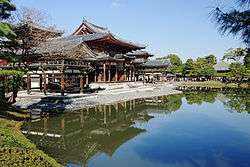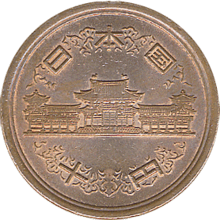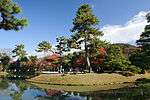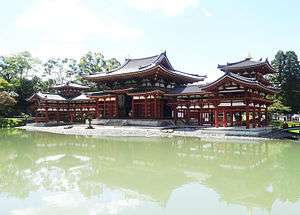Byōdō-in
- For the Arena in Debrecen, Hungary see Fonix Hall.
- For the replica temple in Hawaii, see Byodo-In Temple.
| Byōdō-in 平等院 | |
|---|---|
|
Phoenix Hall, a National Treasure | |
| Basic information | |
| Location | 116 Ujirenge, Uji, Kyoto Prefecture |
| Affiliation | Independent |
| Deity | Amida Nyorai (Amitābha) |
| Country | Japan |
| Website | http://www.byodoin.or.jp/ |
| Architectural description | |
| Founder | Fujiwara no Yorimichi |
| Completed | 1052 |
Byōdō-in (平等院) is a Buddhist temple in the city of Uji in Kyoto Prefecture, Japan, built in late Heian period.[1] It is jointly a temple of the Jōdo-shū (Pure Land) and Tendai-shū sects.[2]
History


This temple was originally built in 998 in the Heian period as a rural villa of high-ranking courtier Minamoto no Shigenobu, Minister of the Left. The property was purchased from Minamoto no Shigenobu's wife after he died by Fujiwara no Michinaga, one of the most powerful members of the Fujiwara clan. The villa was made into a Buddhist temple by Fujiwara no Yorimichi in 1052. The most famous building in the temple is the Phoenix Hall (鳳凰堂 Hōō-dō) or the Amida Hall, constructed in 1053. It is the only remaining original building, surrounded by a scenic pond; additional buildings making up the compound were burnt down during a civil war in 1336.
The main building in Byōdō-in, the Phoenix Hall consists of a central hall, flanked by twin wing corridors on both sides of the central hall, and a tail corridor. The central hall houses an image of Amida Buddha. The roof of the hall displays statues of the Chinese phoenix, called hōō in Japanese.
The Phoenix Hall, completed in 1053, is the exemplar of Fujiwara Amida halls. It consists of a main rectangular structure flanked by two L-shaped wing corridors and a tail corridor, set at the edge of a large artificial pond. Though its official name is Amida-dō, it began to be called Hōō-dō, or Phoenix Hall, in the beginning of the Edo period. This name is considered to derive both from the building's likeness to a phoenix with outstretched wings and a tail, and the pair of phoenixes adorning the roof.
Inside the Phoenix Hall, a single image of Amida (c. 1053) is installed on a high platform. The Amida sculpture is made of Japanese cypress and is covered with gold leaf. It was executed by Jōchō, who used a new canon of proportions and a new technique, yosegi, in which multiple pieces of wood are carved out like shells and joined from the inside. The statue measures about three meters high from its face to its knees, and is seated. Applied to the walls of the hall are small relief carvings of celestials, the host believed to have accompanied Amida when he descended from the Western Paradise to gather the souls of believers at the moment of death and transport them in lotus blossoms to Paradise. Raigō paintings on the wooden doors of the Phoenix Hall, depicting the Descent of the Amida Buddha, are an early example of Yamato-e, Japanese-style painting, and contain representations of the scenery around Kyoto.
There is a Jōdo-shiki garden with a pond in front of the building, which in 1997 was dredged as part of an archeological dig. The gardens are a nationally designated Historic Site and Place of Scenic Beauty.[3]
The Byōdō-in museum stores and displays most of Byōdō-in's national treasures, including 52 wooden Bodhisattvas, the temple bell, the south end Phoenix, and other historically noteworthy items.
Japan commemorates its longevity and cultural significance by displaying its image on the 10 yen coin,[4] and the 10,000 yen note features the phoenix image. In December 1994, UNESCO listed the building as a World Heritage Site as part of the "Historic Monuments of Ancient Kyoto". The Phoenix Hall, the great statue of Amida inside it, and several other items at Byōdō-in are national treasures.
A half-size replica of the temple was completed on June 7, 1968 in the Valley of the Temples (O'ahu, Hawaii).
The Japanese posts issued three definitive postage stamps showing the phoenix hall, each prepaying the then postal rate for a surface mail foreign letter: 24.oo yen 1950, 24 yen 1957 and 30 yen 1959. Stamps were produced by the costly engraving method, showing the appreciation of the hall.
Entering the complex grounds costs 600 yen for adults, and includes access to the gardens and the museum. An entry pass to the Phoenix Hall, newly restored as of March 2014, costs an additional 300 yen and can be purchased near the gate.
Gallery
-

The head of the Jōchō statue of Amida is visible in this photo of the Phoenix Hall.
-

Left side of Phoenix Hall
-

The garden in front of the Phoenix Hall.
-

Kannondo
-

Omotemon, the main gate.
See also
- Battle of Uji (1180)
- List of National Treasures of Japan (temples)
- List of National Treasures of Japan (sculptures)
- List of National Treasures of Japan (paintings)
- List of National Treasures of Japan (crafts-others)
- For an explanation of terms concerning Japanese Buddhism, Japanese Buddhist art, and Japanese Buddhist temple architecture, see the Glossary of Japanese Buddhism.
- Shinden-zukuri
References
- ↑ Asian Historical Architecture: Byōdō-in.
- ↑ Byōdō-in official web site.
- ↑ "平等院庭園". Agency for Cultural Affairs. Retrieved 10 February 2012.
- ↑ Kyoto Travel: Byōdō-in.
External links
| Wikimedia Commons has media related to Byodo-in. |
- Official homepage (in Japanese)
- Official homepage (in English)
- Japan National Tourism Organization: Byodo-in Temple
Coordinates: 34°53′22″N 135°48′28″E / 34.88944°N 135.80778°E

